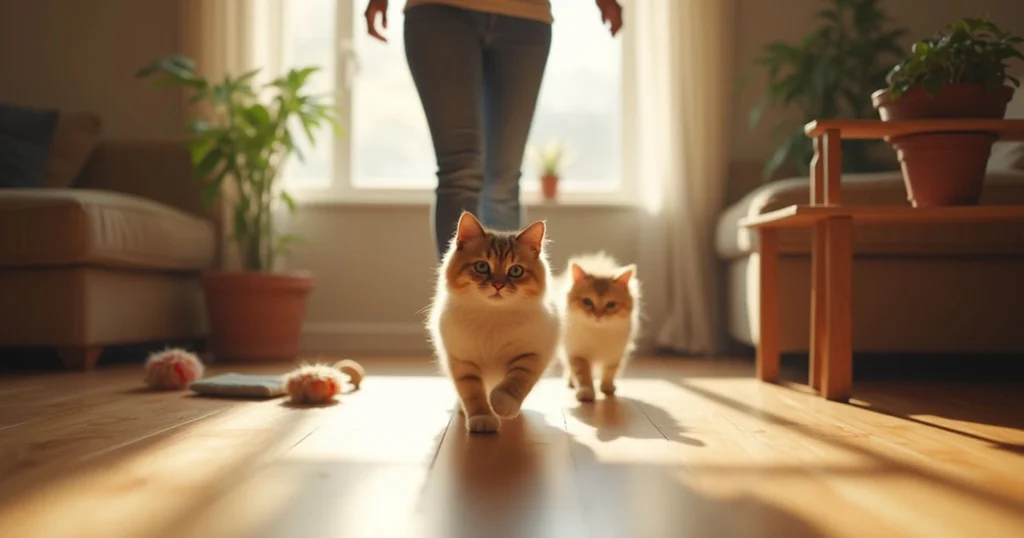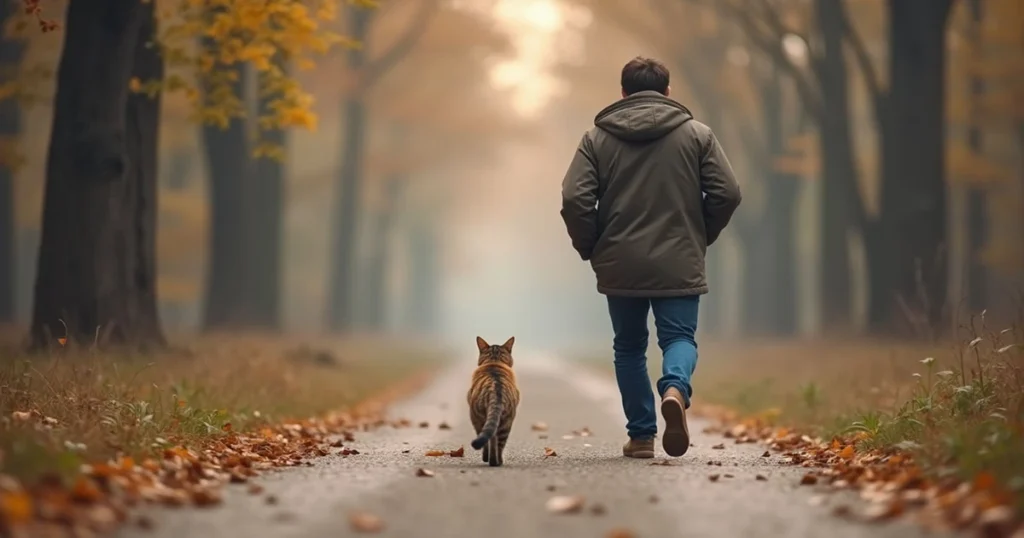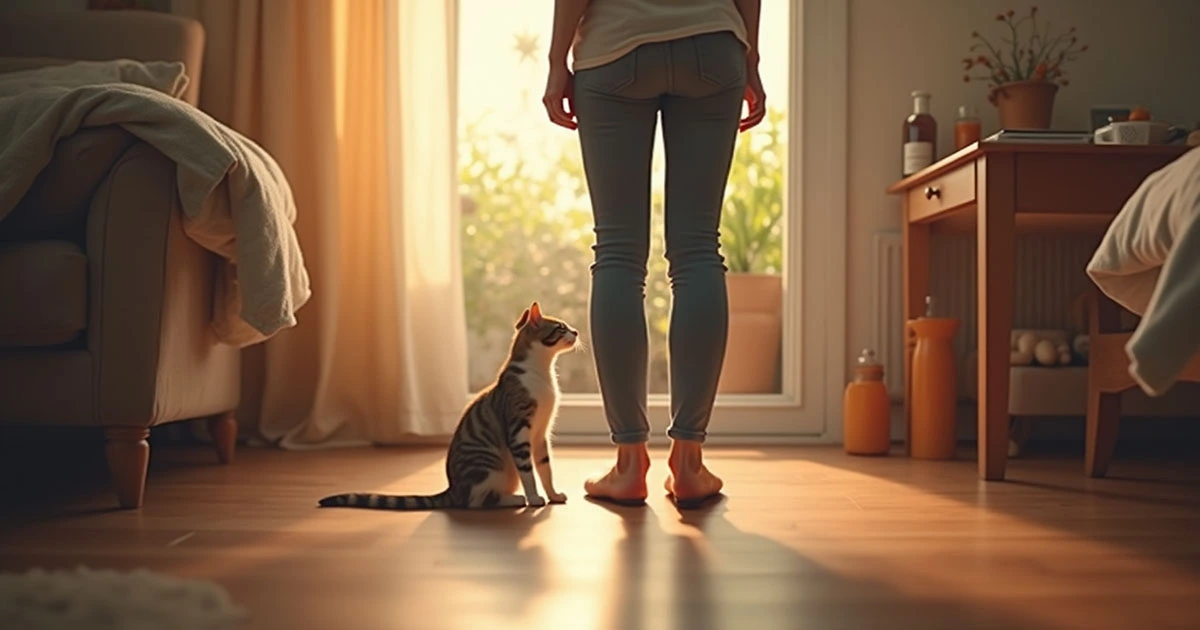Cats have a special way of winning our hearts. But when they follow us everywhere, it makes us wonder. Is it a sign of a strong bond, or could it mean there’s a problem?
Understanding why your cat follows you can help. It might show if this behavior is cute or if it’s a sign of something more serious.
Cats are more than just pets; they’re complex beings. Their reasons for following us can be many. By looking into their history with humans and their body language, we can learn a lot.
It’s important to know the difference between a loving cat and one that’s too attached. Knowing the signs of obsession can help us have a better relationship with our cats.
Table of Contents
Understanding: why my cat follows me everywhere
Have you noticed your cat following you everywhere? This habit, referred to as ‘cat following,’ can be both charming and intriguing. To understand why your cat follows you, let’s explore the roots of this behavior.
Natural Instincts vs. Learned Behaviors
Cats are naturally curious and social. They have a strong drive to observe and interact with their environment and people. This instinct is strengthened by the positive reinforcement of attention, affection, and threats.
Some cats also learn to follow through on experiences. For example, if a cat associates your presence with food or play, they may follow you for these rewards.
The Evolution of Feline-Human Bonds
The bond between cats and humans has grown over centuries. As cats adapted to living with us, they developed a strong attachment to their human caregivers. This bond, similar to a parent and child relationship, makes them want to stay close and follow their owner.
Reading Your Cat’s Body Language
Understanding your cat’s following behavior starts with their body language. A cat following you with a relaxed posture and soft eyes may be seeking companionship. On the other hand, a tense cat with dilated pupils and a twitching tail may be anxious or protective, needing space or a change in interaction.
By recognizing these factors and your cat’s cues, you can better understand and address their following behavior. This helps cultivate a harmonious and balanced connection with your feline friend.

| Behavior | Interpretation |
|---|---|
| Relaxed posture, soft eyes, gentle tail | Seeking companionship and affection |
| Tense posture, dilated pupils, twitching tail | Feeling anxious or protective, needs space |
My Cat Follows Me Everywhere: The Science Behind the Behavior
If your cat always follows you, you might wonder why. Cat psychology explains why they love to be by our side. It’s a mix of love and instinct.
Cats see us as safe and secure, just like kittens do with their caregivers. They feel close and comforted when they’re near us. This feeling comes from a hormone called oxytocin, which helps them bond with us.
But there’s more to it than just feelings. Cats have an instinct to follow a leader. They recognize us as members of their social circle. They might follow us to learn or to stay safe.
| Reason for Following | Underlying Behavior |
|---|---|
| Attachment and Security | Oxytocin-driven social bonding |
| Instinctual Hunting Behaviors | Desire to learn from a “leader” |
| Resource Guarding | Protecting access to food, water, and shelter |
So, your cat’s constant presence is not creepy. It shows a deep bond between you two. Knowing why they follow us helps us connect better with them.
The Psychology of Cats as Social Animals
As pet psychology shows, cats are naturally social. They love to follow their owners everywhere. This behavior comes from their past. It helps us understand why your cat follows you so much.
Territory and Resource Guarding
Cats are territorial. They follow you to guard their space and resources. This gives them a sense of security and authority.
Social Bonding Patterns
Cats bond strongly with their owners. They see them as part of their group. This bond grows when they’re together often. So, they follow to stay connected.
Communication Through Proximity
Cats use closeness to talk to us. They show love, seek comfort, or check on us. By staying near, they share their feelings and needs.
Knowing how cats are social helps us get why they follow us. It deepens our connection, making the relationship more fulfilling and enjoyable.
Signs of Healthy vs. Obsessive Following Behavior
Cats often follow their owners, showing love and attachment. But, it’s key to know the difference between normal and obsessive behavior. This helps keep a healthy bond with your cat.
A healthy cat bond shows through following and seeking attention. They may follow you, curl up near, or ask for attention. But, if following becomes too much, it might be a sign of a problem.
Look out for these signs of obsessive behavior:
- Constant proximity: If your cat never leaves your side, even when you’re sleeping or using the bathroom, it may be a sign of an unhealthy attachment.
- Distress when separated: Healthy cats can handle short times apart. But, an obsessive cat may get anxious, make a lot of noise, or act out when you’re not there.
- Interference with daily activities: If your cat’s following stops you from doing things or messes with your sleep, it’s a sign of an unhealthy obsession.
Knowing the difference helps you address any issues. This way, you can have a balanced, healthy relationship with your cat.
| Healthy Following Behavior | Obsessive Following Behavior |
|---|---|
| Moderate, occasional following | Constant, unrelenting proximity |
| Able to tolerate brief periods of separation | Becomes distressed when separated |
| Does not interfere with daily activities | Disrupts daily routines and sleep patterns |
How Your Daily Routine Influences Your Cat’s Attachment

As a cat owner, you might have noticed your cat’s behavior is linked to your daily routine. Things like feeding times and activities can affect how attached your cat is to you. Understanding this relationship can help you see why your cat might always be by your side or seem like a creepy stalker.
Feeding Schedules and Following Patterns
Cats love routine, especially when it comes to food. If you feed them at the same times every day, they learn to rely on you for meals. This can make them more likely to follow you, hoping for their next snack. Keeping a regular feeding schedule can make your bond with your why does my cat follow me friend stronger.
Activity Timing and Cat Behavior
Your daily activities also shape your cat’s behavior. Cats are most active at dawn and dusk, which is why they might follow you more during these times. Knowing when your cat is most active can help you manage their following behavior better.
Sleep Patterns and Companionship
Both you and your cat’s sleep patterns can affect how much your cat follows you. Cats love to nap and often want to be near their owners when they sleep. If your sleep times match, your cat might want to be close to you, seeking comfort.
Understanding how your daily habits affect your cat’s attachment can help you manage their constant companion behavior. Knowing what drives their following can help you find a balance in your relationship. This way, you can meet your cat’s needs while also respecting your personal space.
When Cat Following Indicates Health or Anxiety Issues
Your cat’s constant presence can be sweet, but it might also mean they’re not feeling well. It’s important to figure out why they’re always by your side.
Some health issues, like hyperthyroidism or cognitive dysfunction, can make cats more clingy. Also, anxiety disorders can cause them to follow you everywhere, especially if their routine changes.
- If your cat is always by your side and seems unhappy, talk to your vet. Look for signs like:
- They meow a lot or seem upset when you’re apart
- They groom too much, pace, or can’t relax
- They’re too clingy and don’t want to explore on their own
- Your vet will check for health problems and might suggest seeing a behaviorist if needed.
- Fixing the reason behind your cat’s psychology and obsessive pet behavior can help them feel better. This will make your bond stronger and healthier.
| Behavior Indicator | Potential Cause | Recommended Action |
|---|---|---|
| Persistent vocalization or distress when separated | Anxiety, separation anxiety, or medical condition | Consult a veterinarian or animal behaviorist |
| Excessive grooming, pacing, or restlessness | Stress, anxiety, or medical condition | Consult a veterinarian or animal behaviorist |
| Uncharacteristic clinginess or reluctance to explore independently | Anxiety, insecurity, or medical condition | Consult a veterinarian or animal behaviorist |
Knowing why your cat follows you can help you take care of them better. This way, you can have a happier and more balanced relationship with your pet.
Building a Balanced Relationship With Your Shadow world Cat
Having a clingy cat can be both sweet and tough. To keep a healthy bond, set clear limits, encourage independence, and praise good behavior. These steps help you enjoy your cat’s company without feeling trapped.
Setting Healthy Boundaries
Cats love routine, but they need boundaries to avoid being too clingy. Make sure they know where they can and can’t go, like your bedroom. Also, give them their own spot, like a cat tree, for when you’re away.
Creating Independent Play Time
- Give your cat lots of toys and activities to keep them busy alone.
- Change their toys often to keep them interested and avoid boredom.
- Play with your cat, but also let them play by themselves sometimes.
Reinforcing Positive Behaviors
When your cat acts well, like playing alone or resting calmly, reward them. Use treats, praise, or playtime. This encourages them to keep being a good companion.
Fostering a close relationship with your cat requires striking the right balance—they enjoy your companionship but also value their independence. With patience and consistency, you can have a happy, balanced relationship.
Common Misconceptions About Clingy Cats
When your cat follows you everywhere, it’s easy to think something’s wrong. But, many beliefs about cat psychology and pet psychology are not true. Let’s clear up some myths about clingy cats.
Myth: Clingy Cats Are Abnormal
Actually, it’s normal for cats to be close to their owners. Cats are social and form strong bonds. Following you shows their love and desire for company.
Myth: Clingy Cats Are Unhappy
A cat following you doesn’t mean they’re unhappy or anxious. While too much clinginess might mean a problem, many happy cats just love being near their humans.
Myth: Clingy Cats Require Constant Attention
Just because your cat follows you everywhere doesn’t mean they need you all the time. Cats also like to be alone and enjoy their own activities. Giving them toys and places to climb can help them feel independent.
Learning about pet psychology helps you understand why your cat follows you. With patience and the right steps, you can have a great relationship with your shadow world cat.
Solutions for Managing Your Cat’s Following Behavior
If your cat follows you too much, there are ways to handle it. Make sure they have lots of toys, perches, and fun activities. This helps them not get bored and clingy.
Try changing their behavior with positive steps. Give them treats and praise when you leave. This makes them feel good about being alone. You can also play with them or give them puzzle toys before you go.
Keep a regular schedule and spend special time with your cat. This helps them feel less anxious when you’re away. By fixing the reasons for their behavior, you can have a better relationship with your cat.
FAQ
Why does my cat follow me everywhere?
Cats follow their owners for many reasons. It shows a strong bond but can also mean they’re too attached. Knowing why your cat follows you is key to a good relationship.
Is it normal for my cat to be a constant companion?
It’s common for cats to stick close to their owners. But too much following can be a sign of a problem. It’s important to find a balance between being together and being alone.
When does a cat following its owner become a “creepy stalker” behavior?
Constantly following or meowing too much can be a sign of an unhealthy bond. It might mean your cat is stressed or has a health issue. If it’s affecting your life or theirs, get help from a vet or animal behaviorist.
How can I tell if my cat’s following behavior is normal or a cause for concern?
Healthy following is when your cat is sometimes close, sometimes alone. But if they’re always with you or get upset when apart, it’s a problem. Watch your cat’s body language and overall health to see if they’re okay.
What are some of the reasons why cats follow their owners?
Cats follow for many reasons. They might want security, food, or just to be with you. They also follow due to natural instincts or to feel close to you.
How can I encourage a healthy level of independence in my cat?
To help your cat be independent, try these tips. Give them time to play alone, have routines, and reward them for being alone. Also, make sure they have fun things to do when you’re away.
When should I seek professional help for my cat’s following behavior?
Get help if your cat’s following is causing problems. This includes if they’re always with you, meowing a lot, or seem stressed. Also, if you think it might be a health issue, see a vet or animal behaviorist.

